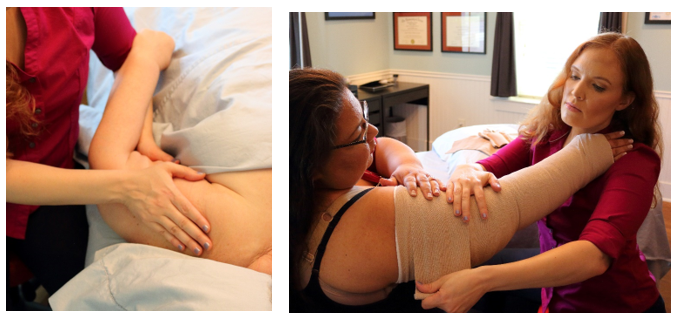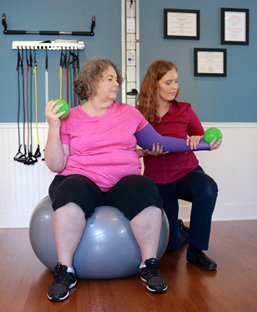Lymphedema: Illuminating the Medical Condition that Impacts Many Cancer Patients
In a time of Google, Siri, and Alexa, lymphedema is still a term with which most people are not familiar. Lymphedema is a condition experienced by individuals impacted by cancer. Specifically, one in five women who have undergone breast cancer treatment will acquire lymphedema, 90% of head and neck cancers can lead to lymphedema, and 37% of patients with gynecological cancers experience lymphedema. The risk of lymphedema is lifelong for cancer patients with the risk being highest in the first 5 years post-diagnosis. To learn more, we sat down with certified lymphedema therapist and Doctor of Physical Therapy; Angela Wicker-Ramos, PT, DPT, CLT-LANA, owner of Cancer Rehab and Integrative Medicine. Dr. Wicker-Ramos shared her insight, knowledge, and specialization with lymphedema highlighting the expertise of Austin’s first specialty oncology rehab and integrative medicine clinic.

What is Lymphedema?
First, let’s break down the word lymphedema. “Lymph” refers to your lymphatic system and “edema” means swelling. The lymphatic system is made up of a large network of lymphatic vessels, nodes, organs, and tissues. The body’s lymphatic system circulates fluid in your body enhancing immune function, aiding your body in fighting disease and infections.
A damaged lymphatic system is unable to move fluid in the body as effectively as it should, bringing the possibility of swelling in in that specific area of the body. Lymphedema is a known risk for anyone who has had radiation or lymph nodes removed. With many cancer treatments including the removal of lymph nodes for cancer staging as well as radiation to the lymphatic system, the risk for damage and ultimately lymphedema is possible. Overall, lymphedema is considered a potential side effect of cancer treatment.
How do you know if you have Lymphedema?
One of the first symptoms of lymphedema is a heaviness or achiness in the area where you are at risk. Swelling can follow dull pain in a specific area, region, or quadrant of the body affected by lymphatic damage. For example, axillary or armpit lymph nodes circulate fluid through the upper back, arm, and chest. Removal of these axillary nodes due to breast cancer treatment may cause lymphedema in the back, chest, arm, and at times all the way down the hand. Although a known side effect of treatment, the symptoms of lymphedema can be intermittent.
It is important to know that lymphedema is not general swelling. Unlike lymphedema, general swelling can be caused by medications, chemotherapy, steroids, or immune therapy. General swelling may present all over the body. Lymphedema occurs specifically in the area of the body where the lymphatic system was injured.
What does Lymphedema mean for a cancer patient?
According to Dr. Wicker-Ramos, our bodies are like factories. Factories have an input of materials and an output of product. The lymphatic system is like a factory that is constantly distributing fluid throughout the body, delivering materials and supplies. Lymph node removal is equivalent to laying off multiple workers in the factory. Fewer workers in the factory equates to less output. Fewer “workers” in the human body means there is less ability for fluid to move out of the affected area.
Ultimately, the fluid in that area may become congested or backed up, much like a traffic jam, states Dr. Wicker-Ramos. Just like a real-life traffic jam, the back of the jam cannot move forward until the front is cleared. For someone with cancer who has sustained damage to the lymphatic system, lymphedema can be a serious problem, causing “jams” in or around the area of treatment.
While cancer type is not a determinant of lymphedema, the intensity and the frequency of radiation treatment can impact the prevalence of lymphedema. The location of the cancer treatment as well as the level of lymphatic damage can also impact the likelihood of lymphedema occurring.
Cancer patients who experience lymphedema will always be susceptible to swelling, even if symptoms are improved. The symptoms of lymphedema can be reduced and managed with therapy. However, once the lymphatic system is damaged; it is damaged. While lymph nodes do not regenerate once removed, lymphatic vessels can regrow over time. Overall, managing lymphedema as it occurs is pertinent to reducing the symptoms and preventing symptom progression.
What treatments are out there for Lymphedema?
Dr. Wicker Ramos walked us through many gold standard treatments for lymphedema including Complete Decongestive Therapy (CDT), compression, manual lymphatic drainage, exercise, and education. CDT includes the following:
1. Clinically proven to be effective, Complete Decongestive Therapy (CDT) performed by a certified lymphedema therapist is a recommended treatment for lymphedema. CDT includes Manual Lymphatic Drainage (MLD) a hands-on manual technique. The therapist can help reroute fluid from the affected area to an area where the lymphatic system is intact. This therapy has many benefits including softening the skin’s firmness, increasing the efficiency of the lymphatic system, and palliation. MLD can also be taught to the patient, giving them tools to address their needs as they occur.
2. Compression is another form of therapy coming in two forms. Compression garments or sleeves can be worn on the affected area to help reduce swelling or worn preventatively. If the swelling is significant, then compression bandaging is recommended. Multi-layered bandaging can be done in the clinic by a therapist to help reduce problematic swelling. Once managed, compression garments can help maintain the progress made by bandaging.
3. Exercise or decongestive exercise can help move lymphatic fluid through the body. The primary way lymphatic fluid moves through the body is by muscles contracting and relaxing. Physical activity and movement are imperative as a part of lymphedema treatment. Beginning with light weight, low endurance, low impact, and comfortable exercises is important. Progression is possible but must be taken gradually. Taking precautions to avoid inflammation or injury is important with lymphedema and exercise.
4. The support of loved ones and family can be very beneficial in the treatment of lymphedema. Caregivers can help with manual lymph drainage, be the extra hands needed to apply compression garments, and provide reminders to exercise and eat healthy. Fatigue is a common side effect in the cancer journey and the support of others can be advantageous.
5. Lastly, education on skin care maintenance to help reduce the risk of infection and progression of lymphedema is essential to symptom management. Skin care can include protecting the skin during chemotherapy and radiation, minimizing the effects of inflammation and sensitivity, and maintaining the skin’s natural barrier function.

I have just been diagnosed with cancer, what can I do to manage lymphedema?
While everyone’s cancer journey is different, there are some steps that can be taken to help reduce the occurrence of lymphedema. Research shows that individuals with a lower body mass index are at lower risk of developing lymphedema. Fat cells, having an inflammatory component to them, can release hormones that can damage lymphatic vessels.
Side effects can be less significant from cancer treatment if starting from the healthiest place possible. Physical activity, exercise regimens, hydration, as well as nutrition are all important to preventing lymphedema as well as symptom management. A consultation with a certified lymphedema therapist, even before lymphedema is an issue, can inform patients about their physical health and allow for education about your specific risks.

Things to remember:
- If you have lymphedema there are many therapies available. Lymphedema can be reduced and maintained with professional therapy and an at home program. Speak to your oncologist or cancer care team to learn more.
- Lymphedema can be progressive if not treated early. Lymphedema and general swelling can also be hard to differentiate. It is important to let a medical professional know if you are experiencing any symptoms.
- Movement and exercise are beneficial before and after diagnosis. Let’s get moving!
- Many forms of support are available for Lymphedema. You are not alone! Here are a few to get started:
a. Moving Beyond Cancer Collaborative offers a free monthly Lymphedema online support group
b. Lymphie-Strong- Serves as a central hub for cancer survivors with Lymphedema to support others with Lymphedema
c. Lymphedema Podcast- Answers common questions about Lymphedema
d. Lymphatic Education and Research Network (LEARN)- Share more about current research in the lymphedema field
e. National Lymphedema Network- Offers resources for both medical professionals and cancer survivors
Lymphedema: Illuminating the Medical Condition that Impacts Many Cancer Patients was originally published in Livestrong Voices on Medium, where people are continuing the conversation by highlighting and responding to this story.